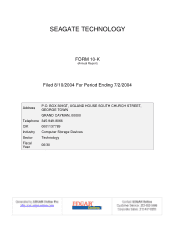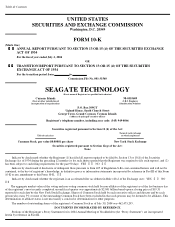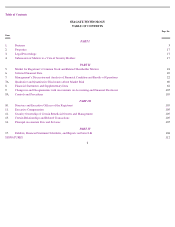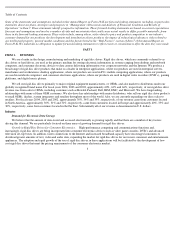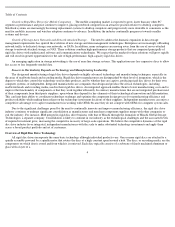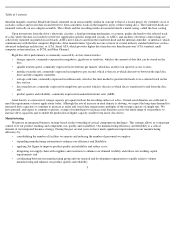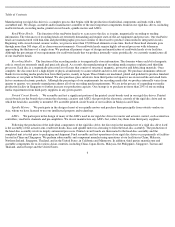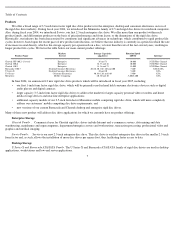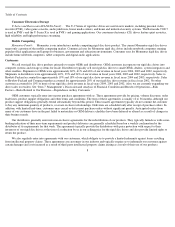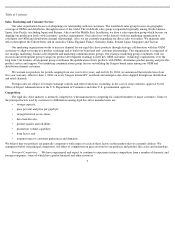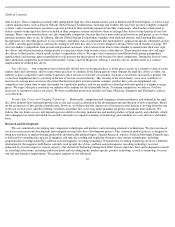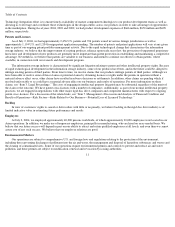Seagate 2003 Annual Report Download - page 5
Download and view the complete annual report
Please find page 5 of the 2003 Seagate annual report below. You can navigate through the pages in the report by either clicking on the pages listed below, or by using the keyword search tool below to find specific information within the annual report.
Table of Contents
Growth in Rigid Disc Drives for Mobile Computing . The mobile computing market is expected to grow faster than any other PC
segment as performance and price continue to improve, placing notebook computers in an attractive position relative to desktop computers.
Notebook systems are increasingly becoming replacement systems to desktop computers and progressively more desirable to consumers as the
need for mobility increases and wireless adoption continues to advance. In addition, the industry continually progresses towards smaller
systems and devices.
Growth of Storage Area Networks and Network Attached Storage . The need to address the dramatic expansion in data storage
management requirements has spurred the evolution of new storage and data management technologies. Enterprises are increasingly offloading
network traffic to dedicated storage area networks, or SANs. In addition, many enterprises are moving away from the use of server-attached
storage to network-attached storage, or NAS. These solutions combine high-performance storage products that are comprised principally of
rigid disc drives with sophisticated software and communications technologies. We expect that the market for these solutions will grow rapidly
and will result in greater opportunities for the sale of high-performance, high-capacity rigid disc drives.
An emerging application in storage networking is the use of near-line storage systems. This application uses less expensive discs to allow
fast access to less frequently needed data.
Success in Our Industry Depends on Technology and Manufacturing Leadership
The design and manufacturing of rigid disc drives depends on highly advanced technology and manufacturing techniques, especially in
the areas of read/write heads and recording media. Rigid disc drive manufacturers are distinguished by their level of integration, which is the
degree to which they control the technology used in their products, and by whether they are captive, producing rigid disc drives for their own
computer systems, or independent. Integrated manufacturers are companies that design and produce the critical technologies, including
read/write heads and recording media, used in their rigid disc drives. An integrated approach enables them to lower manufacturing costs and to
improve the functionality of components so that they work together efficiently. In contrast, manufacturers that are not integrated purchase most
of their components from third-party suppliers, upon whom they depend for key elements of their technological innovation and differentiation.
This can limit their ability to coordinate technology roadmaps and optimize the component design process for manufacturing efficiency and
product reliability while making them reliant on the technology investment decisions of their suppliers. Independent manufacturers can enjoy a
competitive advantage over captive manufacturers in working with OEMs because they do not compete with OEMs for computer system sales.
Due to the significant challenges posed by the need to continually innovate and improve manufacturing efficiency, the rigid disc drive
industry continues to undergo significant consolidation as manufacturers and merchant component suppliers merge with other companies or
exit the industry. For instance, IBM merged its rigid disc drive business with that of Hitachi through the formation of Hitachi Global Storage
Technologies, a separate company. Consolidation is likely to continue in our industry as the technological challenges and the associated levels
of required investment grow, increasing the competitive necessity of large-scale operations. We believe the competitive dynamics of the rigid
disc drive industry favor integrated, independent manufacturers with the scale to make substantial technology investments and apply them
across a broad product portfolio and set of customers.
Overview of Rigid Disc Drive Technology
All rigid disc drives incorporate the same basic technology although individual products vary. One or more rigid discs are attached to a
spindle assembly powered by a spindle motor that rotates the discs at a high constant speed around a hub. The discs, or recording media, are the
components on which data is stored and from which it is retrieved. Each disc typically consists of a substrate of finely machined aluminum or
glass with a layer of a
4

